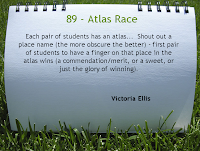Looking for something new...check this out!
The link below will take you to the full slide show....explore the many exciting and innovative ways to teach geography
Below are some activities that I found particularly interesting. All the methods move beyond the lower levels of understanding and remembering of Bloom's toxonomy. These methods address the higher levels of thinking and learning; applying, analyzing, evaluating, and creating.
The powerful elements of Social Studies are addressed for each activity.
This activity suggests student to walk 5 minutes in any direction and take a picture.
This could be great to work on map skills, or put the pictures together for a map of the local area.
This is meaningful, integrative and active
Have staff, faculty, students and families send postcards when they travel. The postcards could then be linked to a map for an awesome display and encourage discovery about new places while learning the relationship between regions.
This is meaningful and challenging
Capture curiosity and engage students by encouraging students to develop 60 second films and share them. Students can learn from real world examples and share their learning in meaningful ways.
This is integrative, challenging and active
Posterous is a website where items can be published in a safe space to share that allows you to control who sees what. This provides students with an excellent forum to share their work and learn from others.
This is value based, active, challenging and meaningful
This activity asks students to draw what they hear from an oral reading of a news article of geographical significance. This taps into student's creativity and allows for an alternate to student written responses. Allows for multi-sensory learning and discovery.
This is integrative and active
This suggests to provide a mystery picture to students that they can comment on through voice thread. This offers a great way to introduce a topic, pre-assess and activate student's prior knowledge.
This is integrative, challenging and active
Using montage a google create images related to a specific topic. This is a great way to start a lesson, stimulate conversation and get students ready for learning.
This is challenging and active
This activity asks students to bring in articles of geographical significance to the. This articles can be displayed around a world map. This can allow for a discussion of geography as well as analysis of various news reporting.
This is integrative, value based and active
Students sit back to back in this activity and one student in the pair describes the image to the other who must try to draw the image. This is a great creative thinking activity and develops effective communication skills. Can easily be tied to a number of different lessons.
This is active, integrative and challenging
In this activity students have an atlas and must race to find a specific obscure location. This allows for the active seeking of information using what students already know and provides a forum for learning more geography.
This is meaningful, challenging and active
I encourage you to check out all the ideas..there are so many more that are amazing...see what interests you!
"I affirm that to grow as a teacher, I must remain an alert learner."
-Eric Maisel

































